Plensa, the art of asking for silence
The Barcelona-born artist is displaying a group of sculptures and drawings at the Senda gallery until February. He says they have a “hyperpositive” message that focus attention on the “vibration” of body and thought
“I’m not sure I have to do work that addresses the pandemic” “More than silence, it asks us to speak in whispers to calm the shrieks of society”
Jaume Plensa is very upset with Barcelona. “I don’t feel she’s mine. She’s going through a period of self-denial, as if she has lost interest in herself. I’m lucky to live in Sant Just Desvern, that saves me,” said the sculptor last month at the Senda Gallery, where he is exhibiting a set of sculptures and drawings until February 6.
This same venue on Barcelona’s Carrer Trafalgar organised an exhibition for Plensa in 2016, which saw his reappearance after being absent from Barcelona for many years. “We did a bit of testing to see if people remembered me,” jokes Plensa, but with a humour that exudes the strained relationship he maintains with the city where he was born in 1955.
A year after that exhibition, in 2017, Barcelona’s Museum of Contemporary Art, Macba, took on the first revision of his work two decades after the first one devoted to him by the Miró Foundation. “I think it was the most visited exhibition in the 25-year history of the Macba,” he says. In fact, it received more than 150,000 visitors and there were even queues in Plaça dels Àngels, which was unheard for this museum. But was he really happy about it? The gallery owner, Carlos Duran, gives us the answer: “The conclusion we drew from this is the public’s unanimous desire to see an exhibition by Plensa.” Not wanting to delve further into it, the artist simply says he “completely agrees”.
Past conflicts
Plensa has had many disagreements over the years, one of the most frustrating being the cancellation of his public sculpture project on the beach at Barceloneta. The work was commissioned by former mayor Xavier Trias. The model was ready, but the next mayor, Ada Colau, ruled it out straight away and it has never been discussed again. The piece was to be more than 50 metres high, almost as tall as the Columbus monument.
The disdain for Plensa from his native city is not replicated in other parts of the world. He is now busy with a 22-metre work, one of his iconic head sculptures, which will be erected in New Jersey, on a pier on the Hudson River. “It will be a tribute to water,” he says. In fact, it should have been unveiled in October, but the coronavirus crisis has postponed that until April.
How has the pandemic affected his work? “It hasn’t changed me as an artist at all. I’m not sure I have to do work that addresses the pandemic, I have to think about my work as I see it, which is trying to include a very deep humanistic content that also embraces the pandemic. The pandemic is one more experience. Art has to transcend your time, it can’t be the journalism of the day.” Plensa cites the Senda Gallery exhibition as an example because, although it brings together pieces created before the crisis, “they were conceived with a desire for looking inwards.” “If anything positive has come out of this pandemic, it’s that it’s created the feeling of looking inwards. We have internalised ourselves a lot,” he adds.
The artist sees the exhibition as “a song to silence”. He describes a constant in his work as “the literal fabrication of silence to be able to hear the vibration of your own body and your thoughts. If you don’t know yourself, it’s very difficult for you to get to know others.” The centrepiece, Minna’s words, explicitly implores silence with her finger over her lips. “More than silence, it asks us to speak in whispers to calm the shrieks of today’s society. I don’t think we need to shout more to fight the scream. That’s a mistake. We need to create the silence needed to hear our little voices.” There are two other sculptures, the stylised Laura Asia, born from a pine, and the Invisible Ana, made of mesh, which “helps us understand what we are like inside”. Prices range from 370,000 to 430,000 euros. On the walls of the gallery are a group of drawings (30,000 euros) of sculptural projects in which the artist once again favours transparency: “they are like ghosts embracing the air.” “All of these works talk about what I’m like. And they represent us all,” he remarks.
feature art

